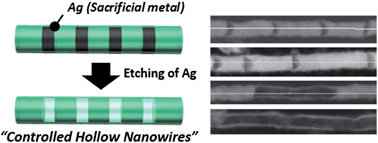Design and fabrication of Ni nanowires having periodically hollow nanostructures†
Abstract
We propose a concept for the design and fabrication of metal nanowires having periodically hollow nanostructures inside the pores of an anodic aluminum oxide (AAO) membrane using a sacrificial metal. In this study, nickel (Ni) and silver (Ag) were used as the base metal and the sacrificial metal, respectively. Alternating an applied potential between −0.4 and −1.0 V provided alternatively deposited Ni and Ag segments in a Ni–Ag ‘barcode’ nanowire with a diameter of 18 or 35 nm. After etching away the Ag segments, we fabricated Ni nanowires with nanopores of 12 ± 5.3 nm. Such nanostructure formation is explained by the formation of a Ni shell layer over the surface of the Ag segments due to the strong affinity of Ni2+ for the interior surfaces of AAO. The Ni shell layer allows the Ni segments to remain even after dissolution of the Ag segments. Because the electroplating conditions can be easily controlled, we could carefully adjust the size and pitch of the periodically hollow nanospaces. We also describe a method for the fabrication of Ni nanorods by forming an Ag shell instead of a Ni shell on the Ni–Ag barcode nanowire, in which the interior of the AAO surfaces was modified with a compound bearing a thiol group prior to electroplating.


 Please wait while we load your content...
Please wait while we load your content...